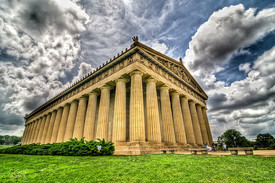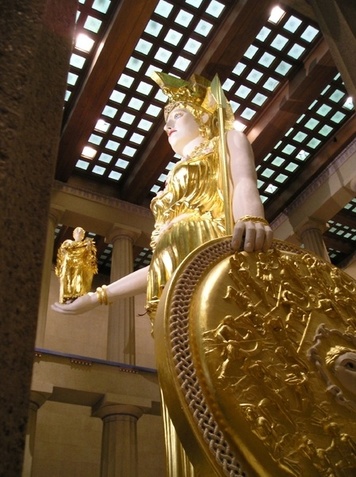About the Parthenon in Tennessee...
The Parthenon stands proudly as the centerpiece of Centennial Park, Nashville's premier urban park. The re-creation of the 42-foot statue Athena is the focus of the Parthenon just as it was in ancient Greece. The building and the Athena statue are both full-scale replicas of the Athenian originals.
Originally built for Tennessee's 1897 Centennial Exposition, this replica of the original Parthenon in Athens serves as a monument to what is considered the pinnacle of classical architecture. The plaster replicas of the Parthenon Marbles found in the Naos are direct casts of the original sculptures which adorned the pediments of the Athenian Parthenon, dating back to 438 B.C. The originals of these powerful fragments are housed in the British Museum in London.
Parthenon Facts
- Nashville's Athena stands 41'10" tall, making her the largest piece of indoor sculpture in the Western World.
- The statue of Nike in Athena's right hand stands 6'4" tall.
- There are eleven snakes represented on Athena's breastplate, bracelets and belt.
- The Athena Parthenos in the ancient Parthenon was considered the greatest achievement of Pheidias, the most acclaimed sculptor of ancient Greece.
- Sculptor Alan LeQuire created Nashville's Athena. The statue was unveiled to the public May 20, 1990.
Facts about the Nashville Parthenon
- The bronze doors weight 7.5 tons each. They measure 24' high, 7' wide and 1' thick. There are two sets (4 doors total) of these enormous doors in the Parthenon. This makes them the largest set of matching bronze doors in the world. The Parthenon doors in antiquity were only slightly lighter and were wooden with a bronze overlay.
- Like its predecessor in Greece, the Parthenon in Nashville faces east. In antiquity this would allow light to come into the building as the sun came up and the doors were opened.
- Until 1988 visitors entered Nashville's Parthenon through the doors at the west end of the building. Visitors now must enter the east end of the building at the sidewalk level. The east façade was considered the "front" of the building by the ancient Greeks.
Architectural Facts of the Parthenon
- The Parthenon in Athens was carved out of Pentelic marble and it took the Greeks approximately 10 years to construct the building, 447-438 B.C.
- Nashville's Parthenon was created from brick, stone, structural reinforced concrete, and cast concrete aggregate. It took the City of Nashville nearly 10 years to build their Parthenon, 1921-1931.
- All horizontal architectural elements arch slightly in the center. This means there are no true straight horizontal lines in the Parthenon. These architectural refinements made the Parthenon look alive and flawless to the human eye. This curvature is repeated in Nashville's Parthenon.
- The Parthenon is 65 feet high at its apex.
- The peristyle consists of 46 Doric columns, 17 on each side, 6 on each end (not counting the corner columns twice).
- All of the exterior columns incline slightly inward. The corner columns are diagonally inclined; that is, they are angled toward both sides. Scholars disagree on the precise reasons for these refinements, but they clearly serve the aesthetic functions of the building.
- The columns of the building differ in diameter from the ones beside them and are all spaced slightly differently.
- All of the columns share a refinement called the entasis, a slight bulge or convex curvature of the shaft. Thus, although the shaft tapers, the largest diameter is about one-third of the way up rather than at the base.
- The interior of the Parthenon is divided into two rooms. The east room is called the Naos and it houses the statue of Athena. The Naos is 93 feet long and 63 feet wide and has a two-story colonnade around three sides. The west room is 44 feet long by 63 feet wide and is called the Treasury Room. In antiquity this room housed the treasure of Athens and the Delian League.
|
TheMagentaHornet.com
© 2009-2024 Holly White & Associates ALL RIGHTS RESERVED |
|



